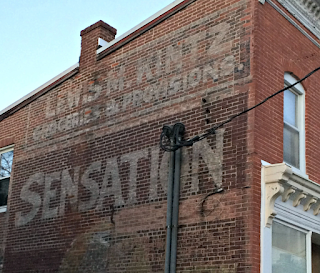Dying Soldier Still Awaits Cemetery Rescue
 |
| Grave of Charles & Columbia Bolden. |
Matt Lake’s entertaining and colorful 2006 book Weird Maryland includes an elaborate Civil-War-ghost-story-turned-graveyard-ritual set in the Finzel cemetery in northeastern Garrett County, nearly at the Pennsylvania state line.
As its only source, the Weird Maryland account quotes, verbatim, Baltimore County paranormal investigator Beverly Litsinger, whose MarylandGhosts.com website seems to be defunct. Here’s the story as Litsinger tells it; I have broken up the long paragraph for online readability.
The town has one road with the old Finzel cemetery located at the end of it on the outskirts of town.
During the Civil War two brothers took up arms on opposing sides – talk about a family feud! One brother fought for the South and the other brother fought for the North; both fought tirelessly. Nonetheless, the two brothers met often in secret inside the small, secluded graveyard to discuss the war and to catch up on stories about the family and various goings-on.
However, late one night the brothers got into a heated argument in the cemetery. Having broached the dangerous topic of politics, they argued about which side was morally right. It was an argument that ended tragically. Push led to shove, which led to concussion when one of the men fell and hit his head on a tombstone.
The Northern brother, who lay bleeding and begging God for his life, looked into the eyes of his Confederate brother and told him that he would remain there and await his brother’s return with help. He told him they could later finish the battle to see who was correct.
The Southern brother ran off, presumably to summon assistance. Whether he just kept going, or met some unexpected fate, no one knows, but the help never arrived and the Yankee brother died.
People say that to this day he is still waiting in the cemetery for his brother to return. Witnesses report that if you walk to the rear of the cemetery, near the largest headstone, you may come eye-to-eye with the baleful stare of the now long gone Union Soldier.
Now, even without knowing the area, anyone who gives a moment’s thought to this story can identify some problems with it.
First of all, if no one knows what happened to the Confederate brother, then how do we know about the brothers’ graveyard rendezvous and quarrel in the first place? The only other witness, the Union brother, did not survive. Whoever found his body in the cemetery would have had a who-done-it-and-why mystery on their hands – on top of the mystery of what the unfortunate soldier was doing there in the first place.
Second of all, while it was not unusual for members of the same family to fight on opposite sides of the Civil War, it would have been bizarre for a brother in blue and a brother in gray to have been stationed so close to one another, for so long, that they were able to visit one another “often” – even if each had been routinely able to sneak away from his encampment and back, something that armies then and now tend to frown on.
Anyone who visits the Finzel cemetery will spot further issues with the story. For one thing, the graves are overwhelmingly 20th century. Only a few tombstones include birth dates for men that would have made them of fighting age during the Civil War, and Charles L. Bolden (1843-1933), Henry J. Finzel (1847-1928) and Godfrey Rosenberger (1847-1939) all lived well into the 20th century, their whereabouts fully accounted for, so they could be neither the dead Union brother nor the vanished Confederate brother.
Granted, the oldest graves may be unmarked – and granted, further, that Litsinger’s account does not tell us that either brother grew up in Finzel. The cemetery may simply have been a convenient rendezvous point for the brothers, and the one who died may have been identified and buried in their hometown, far away.
But clearly our set of unlikely assumptions is getting more unlikely all the time, especially since the story’s geography is all wrong. The Finzel cemetery is not at the dead end of a lonely road but alongside a well-traveled highway, and it’s not perpendicular to the road but parallel to it, hugging it closely, so in what direction “the rear of the cemetery” might lie is far from obvious.
Granted, none of this would matter late at night, if teenagers wanted to scare themselves by staging a snipe hunt for a Civil War ghost – in which case, thousands of rural cemeteries would do. One wonders just how widely the story of the feuding Civil War brothers is told, and how often the Cain of this Cain-and-Abel yarn is the one in the blue uniform, rather than the gray.
Sources:
“Finzel Cemetery.” Find a Grave. https://www.findagrave.com/cemetery/80962/finzel-cemetery. Accessed 10 Nov. 2021.
Lake, Matt. Weird Maryland: Your Travel Guide to Maryland’s Local Legends and Best Kept Secrets. New York: Sterling, 2006. New York: Sterling, 2010. Page 222.

Comments
Post a Comment